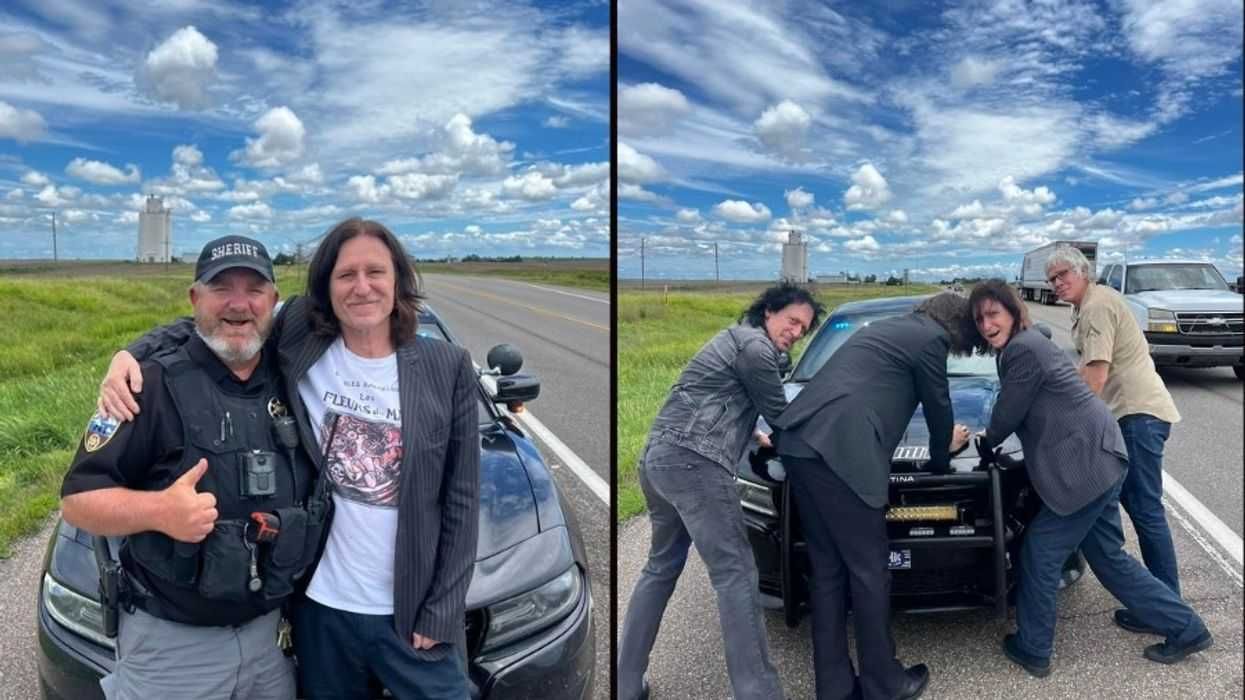For decades, big business and environmentalists have battled over access to America's rivers. Now that dams are being torn down in record numbers, we went back to the one that started it all for some clues about what happens next.Driving on the eastern bank of the Kennebec River, past several "No Trespassing" signs and across a set of railroad tracks, I turn onto a narrow access road pocked with potholes. It cuts in front of the worn, empty buildings of an abandoned tissue factory, part of another era in Maine's capital of Augusta. I spot a guy in a hard hat and pull over. I'm looking for the Edwards Dam, I tell him. He straightens up, takes off his hard hat. "You know, come to think of it," he says, "I think they tore that down."
It was 10 years ago this July that a backhoe punched a hole in the Edwards Dam. For 162 years, the dam had channeled a watershed roughly the size of Connecticut to power sawmills, a textile factory, and, more recently, a 3.5-megawatt electric generator. It had also blocked access to the spawning grounds of 10 native fish and, throughout the 1990s, environmentalists had called on the federal government to tear the dam down."This is the beginning of something that's going to affect this entire nation," U.S. Secretary of the Interior Bruce Babbit said at the time, standing in a parking lot a few hundred feet from where I stand now. Guys in hard hats on the opposite shore then scooped away a temporary gravel dam, allowing the river to flow out unimpeded to the Atlantic for the first time in the better part of two centuries. "You're going to look back in years hence and say, ‘It all began right here on this riverbank,'" Babbit said. Years hence, it appears he was right.
It was 10 years ago this July that a backhoe punched a hole in the Edwards Dam. For 162 years, the dam had channeled a watershed roughly the size of Connecticut to power sawmills, a textile factory, and, more recently, a 3.5-megawatt electric generator. It had also blocked access to the spawning grounds of 10 native fish and, throughout the 1990s, environmentalists had called on the federal government to tear the dam down."This is the beginning of something that's going to affect this entire nation," U.S. Secretary of the Interior Bruce Babbit said at the time, standing in a parking lot a few hundred feet from where I stand now. Guys in hard hats on the opposite shore then scooped away a temporary gravel dam, allowing the river to flow out unimpeded to the Atlantic for the first time in the better part of two centuries. "You're going to look back in years hence and say, ‘It all began right here on this riverbank,'" Babbit said. Years hence, it appears he was right.
The majority of dams that have been removed recently-like the Edwards-have been torn down in the name of fish.The Edwards marks the turning point in America's attitude toward dams. Of the 900 dams that have ever been removed from American rivers, half have come down in the last 10 years. There have always been those who railed against them-fishermen, for example, and environmentalists-but most of the dams removed prior to the 1990s were breached in the interest of public safety, sacrificed to prevent another flood like the one in 1889 when a Johnstown, Pennsylvania, dam was breached, killing 2,200 people. The majority removed recently, like the Edwards, have been torn down in the name of fish.Dams kill fish. They keep species like salmon, shad, alewife, and sturgeon from returning to spawning grounds upstream. They trap sediment and silt in the gravel riverbeds, slow down currents, raise river temperatures, and change the mix of gases in the water. Before the Edwards, as many as 100,000 Atlantic salmon surged upriver past Augusta each year. By the 1990s, salmon in the Kennebec numbered a few dozen.The Army Corps of Engineers keeps a list of large dams in the United States-ones that hold back enough water to be considered dangerous if they were ever to fail. Those number 78,000, and if you count the little ones as well, the number is closer to 2 million. Some were built to generate power or water crops, others to tame floods and to guide ships through impassible rapids. At the height of dam building, in the 1960s, large dams were rising at the rate of five per day.Dams are functional solutions, but they are essentially temporary ones: If you ask an engineer how long any of those dams will last, they will likely say something like 50 years, at which point the costs of maintenance and chances of failure start to rise dramatically. Ten years ago, 25 percent of America's dams were more than 50 years old. Ten years from now, 85 percent of them will be-and they were all built before the Clean Water Act, and the Endangered Species Act. Because it can cost far more to get them up to code than to demolish them, we're at the point, for the first time in history, where we see more dams razed than rising on America's rivers.Nowhere is this felt more than in the Northwest's Columbia River Basin, which drains an area slightly smaller than Texas into the Pacific. At one time, the Columbia River and its tributaries were home to what were arguably the most productive runs of salmon in the world-some 10 to 16 million fish coursing up from the ocean every year. Until 1932, the region didn't have a single dam. In the next 40 years, more than 400 were built, some powering the largest hydroelectric plant in the United States and generating a full three-quarters of the electricity used in the region.Today, 13 species of salmon and steelhead trout in the Columbia River Basin are endangered, and, throughout the past two decades, fishermen, environmentalists, Indian tribes, even the state of Alaska, all asked courts to intervene and force the federal government, which operates 31 of the basin's largest dams, to better protect the region's fish. Increasingly, that has come down to a debate over whether to tear down four specific dams on Washington's lower Snake River.The largest of the country's dams to go so far, removed from Washington's Sandy River in 2007, stood 50 feet tall and generated 22 megawatts of electricity, enough to power 10,000 homes. That small amount of power can be replaced fairly easily by other sources, or simply with surplus electricity that is already in the grid. The four Snake River dams, meanwhile, rise 100 feet apiece and are together capable of generating 3,100 megawatts of electricity. That's roughly enough power to light up Seattle.In hearings about the Snake River dams, some have said that breaching the dams sacrifices one industry (energy) for another (fish). Others say the fish were sacrificed long ago, when the dams were built in the first place. Still, electricity has to come from someplace: The traditional options all have their pitfalls. If the 3,100 megawatts were to be produced with renewable sources, that's a lot of wind turbines. Of all the dams to come down in the United States, it can be argued that the four along the lower Snake River would be the first to really sting.
Like a lot of things in the natural world, rivers tend to fix themselves once humans get out of their wayAfter presiding over the case for over a decade, a federal judge recently hinted that he had grown tired of government delays. This May, for the first time, he explicitly put breaching on the table if fish recovery by other means is less than swift. If the decision to breach the Edwards was a milestone, it was a relatively cheap and painless one, breaking little but precedent. The next 10 years will tell how far that precedent will go.On the other side of the Kennebec River, where the Edwards Mill used to be, is a new public park with a long, freshly paved parking lot. On weekends in the summer, there's a farmer's market, but most of the time it's deserted, and you can climb down around the chain-link fence and touch what's left of a dam: twisted rebar sticking out of the concrete, a severed I-beam pointing off toward the opposite shore.Like a lot of things in the natural world, rivers tend to fix themselves once humans get out of their way. In the past decade, water quality has improved along the Kennebec so drastically that the state has reclassified it, changing restrictions on what you can put into the river to ensure that level of quality continues. Property values, once sagging along the stagnant water behind the dam, have risen to the levels of upriver neighborhoods. The fish are coming back. Earlier this year, a video of a sturgeon in the Kennebec was posted on YouTube; the last time sturgeon were able to pass north of Augusta, Nathaniel Hawthorne wrote about it in his journal. The dam went up; the dam came down. It happened here; it can happen elsewhere.It's possible, with effort, to imagine this seamless river bisected by a thick wall of logs and rock, two stories tall and three football fields across. Mostly, though, it's like it was never even there.

















 Screenshots of the man talking to the camera and with his momTikTok |
Screenshots of the man talking to the camera and with his momTikTok |  Screenshots of the bakery Image Source: TikTok |
Screenshots of the bakery Image Source: TikTok | 
 A woman hands out food to a homeless personCanva
A woman hands out food to a homeless personCanva A female artist in her studioCanva
A female artist in her studioCanva A woman smiling in front of her computerCanva
A woman smiling in front of her computerCanva  A woman holds a cup of coffee while looking outside her windowCanva
A woman holds a cup of coffee while looking outside her windowCanva  A woman flexes her bicepCanva
A woman flexes her bicepCanva  A woman cooking in her kitchenCanva
A woman cooking in her kitchenCanva  Two women console each otherCanva
Two women console each otherCanva  Two women talking to each otherCanva
Two women talking to each otherCanva  Two people having a lively conversationCanva
Two people having a lively conversationCanva  Two women embrace in a hugCanva
Two women embrace in a hugCanva 
 A reddit commentReddit |
A reddit commentReddit |  A Reddit commentReddit |
A Reddit commentReddit |  A Reddit commentReddit |
A Reddit commentReddit |  Stressed-out employee stares at their computerCanva
Stressed-out employee stares at their computerCanva
 Who knows what adventures the bottle had before being discovered.
Who knows what adventures the bottle had before being discovered. 
 Gif of young girl looking at someone suspiciously via
Gif of young girl looking at someone suspiciously via 

 A bartender makes a drinkCanva
A bartender makes a drinkCanva